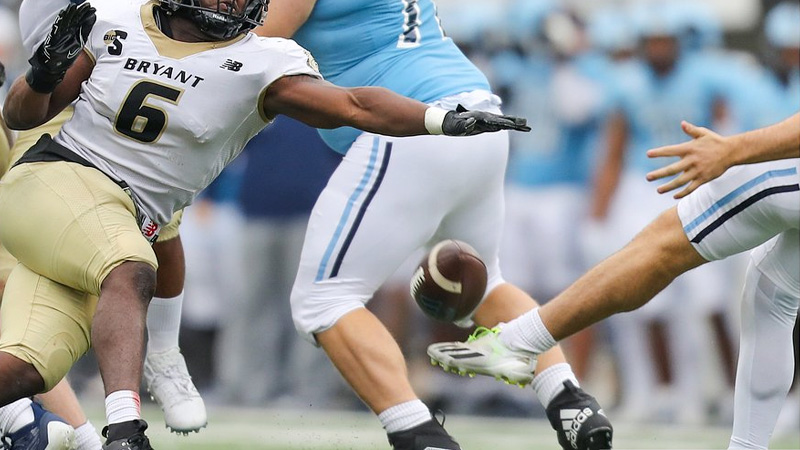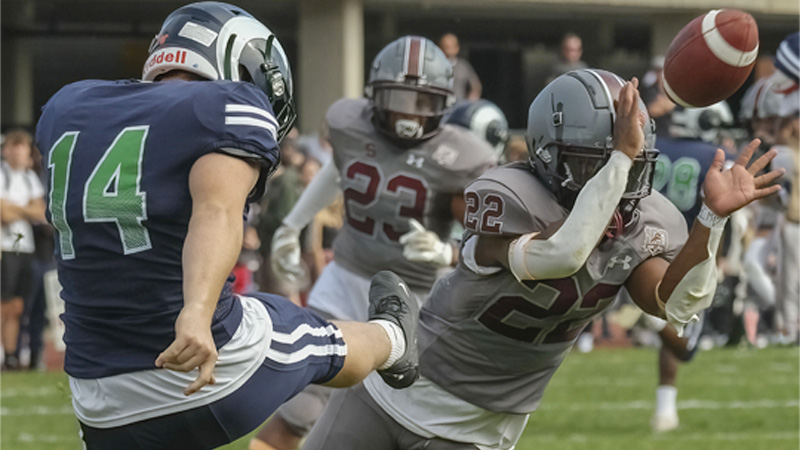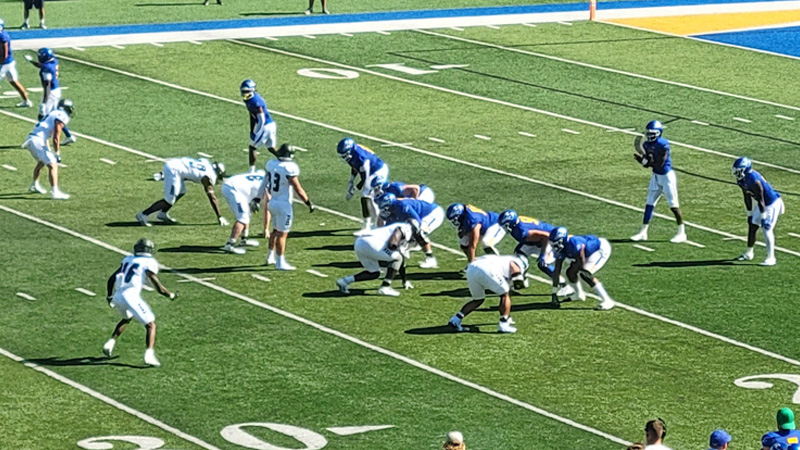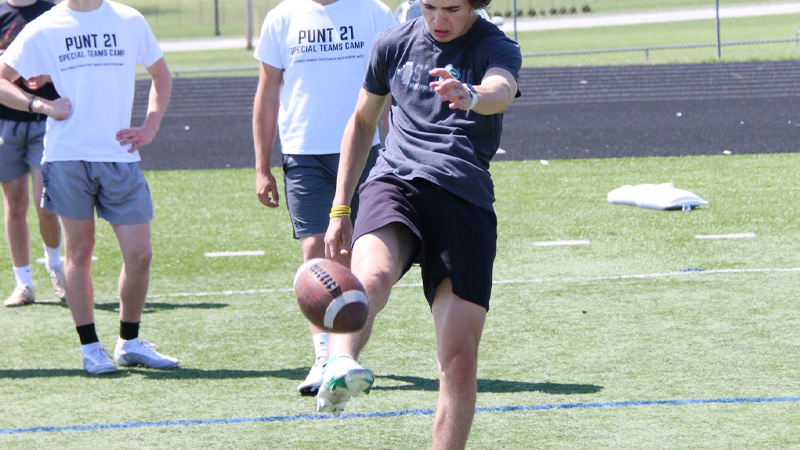American football, with its intricate plays and rules, can sometimes leave newcomers and even seasoned fans puzzled. Among the various terms and strategies, the “punt” stands as a fundamental yet often misunderstood aspect of the game.
In this blog post, we will unravel the mystery behind what does punt means in a football game, shedding light on its significance, when and why it is employed, and the strategies involved.
Whether you’re a die-hard football enthusiast or just looking to enhance your understanding of the game, this article will provide a comprehensive guide to this essential aspect of football strategy. Stay focused.
What Does Punt Mean In A Football Game?
In American football, a “punt” refers to a specific play used by the team on offense to kick the ball to the opposing team.
It typically occurs on fourth down when the offensive team is unable to advance the ball the required distance to earn a first down or score a touchdown.
The primary purpose of a punt is to change field position and flip the field, forcing the opposing team to start their offensive drive as far from the end zone as possible.
During a punt play, the punter, a specialized player, stands behind the line of scrimmage, receives the snap from the center, and then kicks the ball as far downfield as possible.
The punting team has coverage players who attempt to prevent the returner from advancing the ball too far.
Punt plays are essential for strategic field position control in American football and are often used as a defensive tactic to pin the opposing team deep into their territory.
When Is Punting Used in American Football?

Punting is used in American football in several specific situations:
Fourth Down
Punting is most commonly used on fourth down when the offensive team is unable to advance the ball the required distance to earn a first down or score a touchdown.
In this situation, the team usually chooses to punt the ball to the opposing team to change field position.
Field Position Strategy
Teams may choose to punt strategically to improve their field position.
For example, if a team is deep in their own territory and wants to avoid giving the opposing team a good field position, they may choose to punt on earlier downs to move the ball further down the field.
Pinning the Opponent
Punting can be used to pin the opposing team deep into their own territory.
Punters aim to kick the ball high and far, making it difficult for the returner to advance the ball, ideally forcing the opposing team to start their offensive drive as close to their own end zone as possible.
Preventing Returns
Punting can also be used strategically to prevent the opposing team’s returner from gaining significant yardage. Punters may try to kick the ball out of bounds or use directional punts to limit the returner’s opportunities.
Punting is primarily used on fourth down, but it can also be employed strategically to control field position and limit the opposing team’s offensive opportunities.
The Rules of Punting
The rules of punting in American football are governed by the National Football League (NFL) and college football regulations. Here are the key rules and guidelines for punting:
Line of Scrimmage
The punting team must line up behind the line of scrimmage. The line of scrimmage is an imaginary line where the previous play ended.
The punter receives the snap from the long snapper, who is usually positioned at the line of scrimmage.
Snap
The snap is delivered to the punter by the long snapper. It must be accurate and catchable for the punter to kick the ball.
Punt Formation
The punting team typically lines up with several players (usually the punter and some blockers) behind the line of scrimmage to protect the punter from the opposing team’s rush.
The rest of the players usually serve as coverage players to tackle the returner.
Kicking
The punter kicks the ball after receiving the snap. The primary objective is to punt the ball as far downfield as possible while maintaining accuracy and hang time.
The punter must avoid having their kick blocked by the opposing team.
Out of Bounds
Punters often aim to kick the ball out of bounds near the opponent’s goal line to prevent a return.
Fair Catch
If a returner signals for a fair catch by waving their arm above their head, the opposing team is not allowed to tackle them. The returner is then given the opportunity to catch the ball without fear of being hit.
Downing the Ball
If the punting team downs the ball before the returner can pick it up, the ball is considered dead, and the receiving team takes possession of that spot.
Coverage Rules
The players on the punting team must adhere to rules that prevent them from interfering with the returner before they catch the ball.
Returner’s Rights
Once the returner catches the punt, they have the opportunity to attempt a return. The returner’s goal is to advance the ball as far as possible while evading the punting team’s coverage players.
Penalties
Penalties can occur during punts, such as holding or illegal blocking by the punting or receiving team. These penalties can result in yardage gains or losses.
Touchback
If the punted ball goes into the end zone without being touched by the receiving team, it results in a touchback, and the opposing team takes possession at their own 20-yard line.
These rules ensure that punting plays a crucial role in the strategic aspect of American football, allowing teams to control field position and gain an advantage in the game.
American Football Punting Strategies

Punting strategies in American football are diverse and can vary depending on the specific game situation and a team’s goals. Here are some common punting strategies employed by teams:
Field Position Control
One of the primary purposes of punting is to change the field position in the game. Teams often punt when they are deep in their own territory and face a long distance to gain a first down or score.
The goal is to kick the ball deep into the opponent’s territory, making it harder for them to score on their next possession.
Pinning the Opponent
Punters aim to kick the ball high and toward the sideline, ideally inside the opponent’s 20-yard line.
This pins the opposing team deep into their own territory, forcing them to start their offensive drive from a disadvantageous position.
Avoiding Return Yards
Punters may employ strategies to minimize return yards by kicking the ball high with good hang time, making it harder for the returner to gain significant yardage. Directional punting may also be used to limit the returner’s options.
Fake Punts
Occasionally, teams execute fake punts to catch the opposing team off guard. In a fake punt, the punter may pass or run with the ball instead of kicking it.
This strategy is typically used when a team needs a short gain on fourth down.
Rugby-Style Punting
Some punters use a rugby-style punt, where they roll out to the side before punting the ball. This can be effective in avoiding blocked punts and can create unpredictable bounces for the returner.
Quick Punt
In certain situations, teams may opt for a quick punt, where the punter takes a shorter drop and tries to catch the defense off guard by getting the punt off quickly. This is often used to surprise the opposing team and gain field position.
Fake Punt Returns
On rare occasions, teams may employ a fake punt return. This involves simulating a return while the punter retains possession of the ball.
This can be used to deceive the kicking team and create opportunities for big plays.
Directional Kicking
Punters may aim for specific areas of the field to exploit weaknesses in the opponent’s return coverage or to target weaker returners.
Hang Time
Punters aim for high hang time to give their coverage team more time to reach the returner and limit the return yardage.
Coffin Corner
Punters may attempt to kick the ball near the sideline inside the opponent’s 10-yard line, making it extremely challenging for the returner to gain any yardage and forcing the opposing team to start very close to their own end zone.
Successful punting strategies often depend on the punter’s skill, the coverage team’s ability to tackle, and the coach’s understanding of the game situation.
Significance of the Special Teams Unit in Punting

The special teams unit in American football plays a significant role in punting, and its importance cannot be understated. Here are several key reasons why the special teams unit is crucial in punting:
Field Position Control
Punting is all about changing field positions. The special teams unit’s role is to down the ball as close to the opponent’s end zone as possible.
By doing this effectively, they force the opposing offense to start their drive deep in their territory, making it more challenging for them to score.
Punt Coverage
The special teams unit is responsible for covering the punt, which means they must quickly get downfield to tackle the returner.
A well-executed punt coverage prevents the returner from gaining significant yardage, ensuring that the opposing team starts with a poor field position.
Preventing Returns
Special teams players aim to prevent the returner from advancing the ball by maintaining proper lane discipline and tackling techniques.
A strong special teams unit can minimize the threat of big returns, keeping the opposing team at bay.
Blocking and Rushing
On the flip side, the special teams unit also plays a role in blocking and rushing the punter when they suspect a fake punt. This pressure can disrupt the punting operation and lead to turnovers or short punts.
Fair Catches
Special teams players must be aware of the returner’s actions, including fair catches. When a fair catch is signaled, the special teams unit must refrain from making contact with the returner, avoiding penalties.
Field Goals and Extra Points
Special teams units are typically involved in field goal and extra point attempts, which are crucial for scoring points in football games.
Onside Kicks
In certain situations, teams may attempt onside kicks, which involve a specialized kicking technique to recover the ball immediately after the kick.
The special teams unit executes this strategy when their team is trailing and needs to regain possession quickly.
Hidden Yardage
The success of a punting play often comes down to hidden yardage gained or lost. Effective special teams can tip the balance in favor of a team by consistently winning the field position battle.
Momentum Shifts
A well-executed special teams play, such as a blocked punt or a long return, can create momentum shifts in the game, energizing the team and fans and demoralizing the opponent.
The special teams unit plays a vital role in punting by controlling field position, preventing returns, and influencing the overall flow and outcome of the game.
FAQs
What is a punt in American football?
A punt in American football is a play where the offensive team kicks the ball to the opposing team on fourth down. The primary aim is to change field position by sending the ball deep into the opponent’s territory.
When is a punt used in a football game?
Teams use punts primarily on fourth down when they can’t advance the ball enough for a first down or touchdown. It’s a strategic move to avoid giving the opposing team a favorable field position.
What happens after a punt?
After a punt, the opposing team takes possession of the ball where it’s caught or downed. Their offense then starts their drive from that spot on the field.
Can the receiving team return a punt?
Yes, the receiving team can attempt to return a punt. The returner tries to gain yardage by running with the ball after catching it. However, they can also signal for a fair catch to avoid being tackled.
What are some punt strategies used in American football?
Common punt strategies include pinning the opponent deep into their territory, minimizing return yardage, and executing fake punts or surprise plays. Punting is a crucial element of field position control in football.
Wrapping Up
In American football, the punt is not merely a routine play; it’s a strategic maneuver that can tip the scales in a game by controlling field position and setting the stage for crucial defensive and offensive decisions.
As we conclude our exploration of what a punt means in a football game, we hope you’ve gained a deeper appreciation for this critical element of the sport.
Understanding the punt’s role and the tactics involved adds another layer of excitement to watching football, highlighting the complexity and brilliance of this beloved American pastime.
So, next time you see that fourth-down punt, you’ll appreciate the strategy and significance behind this seemingly simple play. Thank you so much.







